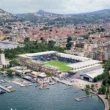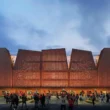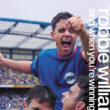The stunning beauty of a piece of art for the stadium and the city of Sevilla.
On 7 September 1958 the Estadio Ramón Sánchez-Pizjuán was opened as the new home of Sevilla Futbol Club and the stadium – named after the former president who had led the club to win a La Liga title and three Copa del Rey – was actually not that different from what we see today.
But, apart from all the specific renovation works that have taken place over the years, one thing was certainly not there in 1958 and today is instead one of the most fascinating and symbolic features of this football ground.
A monumental mosaic celebrating Sevilla and its sporting history covers the western façade of the stadium and was officially unveiled to the public on 23th April 1982.

A gigantic work, entrusted in 1981 to the artist Santiago del Campo by the club’s then president, Eugenio Montes, and which was imagined to celebrate the arrival of the World Cup in Spain – with the Sevilla FC stadium among the host venues.
Representing the club and the “Sevillista” culture
Del Campo worked for almost a year on a marvellous piece covering almost 480 square metres which today welcomes fans and tourists in the square Nervion Plaza.
More than 40 years old, the mosaic today is one of the symbols of the club and also part of the artistic heritage of the city itself.
The panel is ideally divided into three portions: a large Sevilla crest stands out in the center, crowned by an upper horizontal band with the full name of the stadium. Side decorations on a red background partly recall the Moorish architectural and decorative style, typical of the Arabic influence on the city, and mark the space for the two lateral blocks containing the coats of arms of 58 teams that faced Sevilla here in history, until 1982.
In the lower band at the base of the work, eight cartouches are visible, each of them bearing a fundamental year in the history of Sevilla and its stadiums (from left to right):
- 1905 PSS, foundation of the Club and first playing field (Prado de San Sebastián)
- 1908 P.de E., Plaza de España, near which Sevilla played some matches at the beginning of its history
- 1910 M, the year the team moved to play at the Campo del Mercantil
- 1918 RV, the year in which Sevilla moved to the Campo de la Reina Victoria
- 1923 S.H., the year in which Spencer and Herminio became the first Sevilla players to be called up for the national team
- 1929 N, the year of the move to the Nervión ground
- 1958 RSP, the year the Ramón Sánchez Pizjuán stadium was inaugurated
- 1982 M, celebration of the World Cup in Spain 1982, for which the mosaic itself was made
The large mosaic at the Estadio Sánchez-Pizjuán is not only a beautiful covering for a historic building. It is indeed a work of art that connects with the building to which it relates and conveys the city’s identity, becoming a symbol of ‘sevillismo’, the fans’ sense of belonging to their land and their team.
List of teams represented in the mosaic of the Sánchez-Pizjuán stadium in Seville
(work in progress: after various researches, for now we have identified 50 crests out of 58, matching them to the club actually represented – see pic below)
Left band (in alphabetical order, 23 clubs identified out of 28):
- Almeria; Arenas Club; Athletic Bilbao; Bayern Munich (Germany); Barcelona; Benfica (Portugal); Betis; Celta Vigo; Coria CF; Espanyol; RC de Ferrol; Fluminense (Brazil); Granada; Real Jaen; Las Palmas; AC Milan (Italy); Racing Santander; Real Madrid; Reims (France); Sabadell; Standard Liege (Belgium); Valencia; Vasco da Gama (Brazil)

Right band (in alphabetical order, 27 clubs identified out of 30)
- Arsenal (England); Atletico Madrid; Boca Juniors (Argentina); Budapest Honved (Hungary); Cadiz; Cordoba CF; Ferencvaros (Hungary); Glasgow Rangers (Scotland); Hajduk Split (Croatia); Independiente (Argentina); Juventus (Italy); Malaga; Millionarios (Colombia); Newell’s Old Boys (Argentina); Penarol (Uruguay); Rapid Wien (Austria); Real Oviedo; Real Union de Irun; Real Zaragoza; Recreativo Huelva; River Plate (Argentina); Roma/Lazio? (Italy); San Lorenzo (Argentina); Santos (Brazil); Sporting Gijon; Sporting Lisbon (Portugal); Villarreal
follow Archistadia on Instagram
You can read more about stadiums and sports grounds on “TSPORT – Sporteimpianti”, the most renowend sports architecture and technology magazine in Italy, here
Cover image: photo: Frobles / Wikimedia Commons CC BY-SA 4.0
All rights reserved






